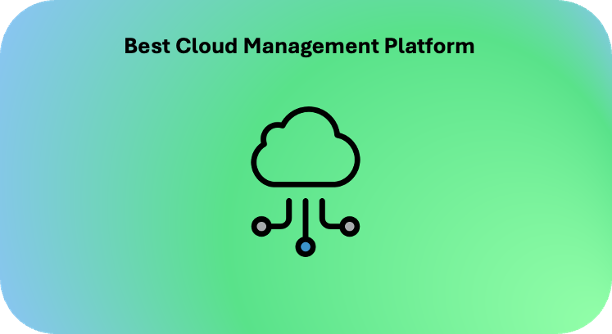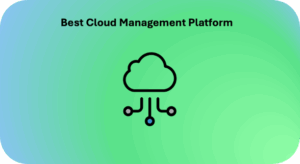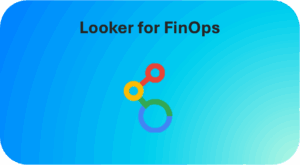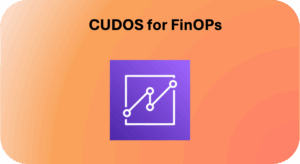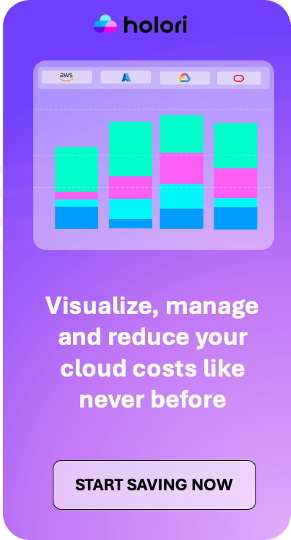The cloud promised simplicity — instant scalability, flexible workloads, and on-demand innovation. Yet as organizations adopted multi-cloud and hybrid strategies, simplicity gave way to fragmentation. Costs became harder to track, governance grew more complex, and operational silos appeared between cloud teams, finance, and developers.
This is where cloud management platforms (CMPs) have become essential. These tools bring order to chaos, giving companies unified visibility over hybrid environments, enforcing policies, automating deployments, and — increasingly — enabling FinOps practices that help teams control and optimize cloud spend.
In 2026, the best CMPs combine cost intelligence with operational automation, helping organizations align technical efficiency with financial accountability. Whether you’re managing workloads across AWS, Azure, GCP, or private data centers, these platforms bridge the gap between engineering and finance.
Here are the 10 best cloud management platforms in 2026, combining FinOps insights with hybrid infrastructure control.
What Are Cloud Management Platforms?
Cloud Management Platforms (CMPs) are the control towers of modern IT infrastructure. They provide a unified way to monitor, optimize, and automate resources across public, private, and hybrid cloud environments.
Instead of juggling different consoles for AWS, Azure, Google Cloud, and on-prem systems, CMPs bring everything together — giving organizations a single view of costs, performance, security, and governance.
A strong CMP doesn’t just collect data; it creates context. It helps teams understand how cloud resources are being used, why costs are rising, and where inefficiencies exist. More advanced platforms integrate FinOps principles, enabling collaboration between engineering, finance, and leadership. That collaboration is key — because cloud optimization isn’t only about saving money; it’s about improving agility, accountability, and long-term scalability.
In 2026, the best CMPs go beyond dashboards. They automate provisioning, enforce compliance policies, identify waste in real time, and integrate with existing DevOps workflows. In short, they act as the operating system for your cloud ecosystem, bridging the gap between technology management and business strategy.

Benefits of Cloud Management Platforms
Cloud Management Platforms deliver a wide spectrum of benefits across the organization — from cost control to performance and governance.
1. Unified Visibility Across Environments
CMPs eliminate cloud blind spots by centralizing data from multiple providers. They allow users to visualize workloads, costs, and dependencies in one interface — essential for teams working in hybrid or multi-cloud setups.
2. Cost Optimization and FinOps Maturity
Modern CMPs provide deep cost analytics, automated rightsizing recommendations, and commitment purchase guidance. They help teams detect idle resources, forecast spending, and allocate budgets accurately across departments — the foundation of a mature FinOps practice.
3. Automation and Operational Efficiency
By automating provisioning, scaling, and policy enforcement, CMPs save valuable engineering time. This frees teams to focus on innovation instead of manual maintenance or repetitive cloud management tasks.
4. Governance and Compliance
CMPs help ensure consistent security and compliance across environments by applying guardrails and tagging standards. They make it easier to track configurations, maintain audit trails, and avoid costly misconfigurations.
5. Improved Collaboration Between Teams
With unified dashboards and shared visibility, finance, operations, and engineering can finally speak the same language. CMPs encourage accountability and data-driven decision-making across the organization.
How to Choose the Right Cloud Management Platform
Selecting the right CMP depends on your cloud maturity, architecture, and internal goals. Not all platforms are built for the same use cases — some focus on FinOps and cost visibility, while others prioritize automation and hybrid orchestration.
Here are the key criteria to evaluate before choosing a Cloud Management Platform in 2026:
- Multi-Cloud & Hybrid Compatibility – Make sure the platform supports all your environments (AWS, Azure, GCP, on-prem, private clouds, etc.) and integrates easily with your existing stack.
- Depth of FinOps Capabilities – Look for advanced cost analysis, forecasting, anomaly detection, and integration with financial systems or business units.
- Automation & Policy Management – A strong CMP should enable automated provisioning, rightsizing, and policy enforcement, not just reporting.
- Ease of Use & Visualization – Good design matters. Teams should be able to quickly interpret data, visualize infrastructure, and act on insights without complexity.
- Scalability & Security – Ensure the platform can scale with your cloud footprint and comply with security standards relevant to your industry.
- Integration Ecosystem – Consider compatibility with DevOps tools (Terraform, Kubernetes, CI/CD), identity providers (SSO), and other monitoring systems.
- Total Cost of Ownership – Evaluate pricing transparency, licensing flexibility, and whether the platform delivers measurable ROI through cost reduction or time savings.
1. Holori – Top Cloud Management Platform: Easy to Set Up and Use, Cost-Effective

Best for: Teams that need cost visibility, cost optimization and infrastructure mapping in one intuitive platform.
Holori stands out as a next-generation cloud management platform that merges FinOps, governance, and infrastructure mapping into a single interface. Designed to simplify cloud governance, it allows users to connect accounts from AWS, Azure, GCP, and other providers to gain a unified view of their cloud environments.
Holori’s FinOps dashboard consolidates costs across all providers and lets users filter by project, team, or tag. Its unique Virtual Tags feature ensures consistent tagging policies even when native tags differ between cloud vendors. Dashboards can be customized with pie charts, bar graphs, tables, and diagrams, allowing both engineers and finance teams to collaborate on cost control.
What makes Holori unique is its Auto-Sync diagram engine. Once connected to your cloud accounts, Holori automatically generates an infrastructure diagram that updates daily or weekly. This visual map shows how resources are configured, making it easy to identify underutilized assets, architecture drift, or overprovisioning.
Holori also supports multi-cloud cost recommendations, alerting, and budget tracking.
Key features:
- Unified multi-cloud cost dashboards
- Real-time budget tracking and alerts
- Auto-generated cloud architecture diagrams
- Virtual Tags for consistent cross-cloud allocation
- Auto-sync infrastructure documentation
Why it stands out: Holori makes cloud costs visible and actionable, bridging FinOps and DevOps like never before. Intuitive, visual, and built for teamwork, it lets tech and finance collaborate seamlessly. Transparent pricing at just 1% of tracked spend — and scalable for companies of any size.
2. CloudHealth by VMware – Best for Multi-Cloud Cost and Policy Management

Best for: Enterprises looking for deep FinOps governance across AWS, Azure, and GCP.
CloudHealth remains one of the most established FinOps and cloud governance platforms. It helps organizations monitor, optimize, and report on multi-cloud spend while enforcing governance and compliance policies.
With CloudHealth, enterprises can create cost allocation rules, track budgets, and analyze spending patterns across teams or business units. The platform integrates seamlessly with VMware environments, making it ideal for companies running hybrid infrastructures.
Key strengths:
- Multi-cloud cost visibility and optimization
- Policy-based governance and automation
- Compliance tracking for frameworks like SOC 2 and ISO 27001
- Strong integration with AWS and Azure billing
Why it stands out: CloudHealth pioneered the FinOps discipline before the term became mainstream. Its maturity and rich policy engine make it ideal for large enterprises that need consistent financial governance across complex multi-cloud estates.
3. Flexera One – Best for Enterprise IT Asset and Cost Governance

Best for: Large organizations managing thousands of resources across clouds and on-prem systems.
Flexera One offers one of the most complete views of enterprise IT assets, bringing together cloud cost optimization, software license management, and hybrid governance. It unifies visibility across AWS, Azure, GCP, and private data centers, making it a favorite among organizations with complex environments.
Flexera helps teams rightsize resources, identify unused licenses, and forecast future costs based on consumption trends. Its integration with CMDB and ITSM tools like ServiceNow makes it a strong choice for FinOps teams aligned with IT governance processes.
Key features:
- Unified visibility for hybrid and multi-cloud environments
- License and software asset optimization
- Forecasting and budget management
- Integration with ITSM systems
Why it stands out: Flexera One bridges FinOps with IT asset management, helping organizations not just reduce cloud waste but optimize their entire software and infrastructure portfolio.
4. Red Hat Cloud Suite – Best for Open Hybrid Cloud Management

Best for: Enterprises running containerized workloads across hybrid and private environments.
Red Hat Cloud Suite combines OpenStack, OpenShift, and CloudForms to provide full lifecycle management for virtual machines, containers, and bare-metal workloads. Its hybrid nature lets companies run and manage workloads seamlessly between on-prem and cloud environments.
CloudForms provides a single pane of glass for infrastructure management, while OpenShift offers an enterprise-grade Kubernetes platform with DevOps automation. Red Hat also integrates FinOps principles through its resource usage analytics and cost reporting.
Key features:
- Unified hybrid cloud control (VMs + containers)
- Deep Kubernetes and CI/CD integration
- Policy and lifecycle automation
- Open-source flexibility with enterprise support
Why it stands out: Red Hat Cloud Suite is the backbone of many enterprise hybrid strategies. It provides open-source freedom with the reliability and governance enterprises expect.
5. OpenStack – Best Open-Source Cloud Infrastructure Manager

Best for: Organizations building private or hybrid clouds with full customization.
OpenStack remains the leading open-source cloud management framework for building and controlling private or hybrid infrastructures. It gives organizations the flexibility to manage compute, storage, and networking resources at scale while avoiding vendor lock-in.
While OpenStack doesn’t provide native FinOps dashboards, it integrates with multiple monitoring and cost-tracking tools. Many organizations pair it with Holori or CloudHealth for unified cost visibility.
Key features:
- Complete open-source IaaS management stack
- Flexible architecture with modular components
- Integration with Kubernetes and CI/CD tools
- Ideal for private or sovereign clouds
Why it stands out: OpenStack’s flexibility and community-driven innovation make it the go-to choice for organizations that want full control over their hybrid or private environments.
6. Morpheus Data – Best for Hybrid Automation and Self-Service Provisioning

Best for: IT teams needing centralized hybrid orchestration with DevOps integration.
Morpheus Data delivers powerful orchestration and self-service provisioning across multi-cloud and on-prem infrastructures. It supports AWS, Azure, GCP, VMware, and Nutanix, providing a unified platform to automate provisioning and enforce policies.
Morpheus integrates deeply with Ansible, Terraform, and Jenkins, allowing teams to embed it into existing DevOps pipelines. Its FinOps module also gives cost visibility across environments, helping organizations align spending with automation.
Key features:
- Hybrid orchestration and policy automation
- Integration with DevOps tools
- Role-based access control
- Built-in cost visibility and reporting
Why it stands out: Morpheus combines strong hybrid orchestration with FinOps capabilities, making it ideal for enterprises scaling across private and public clouds.
7. CloudBolt – Best for Enterprise Self-Service and Governance
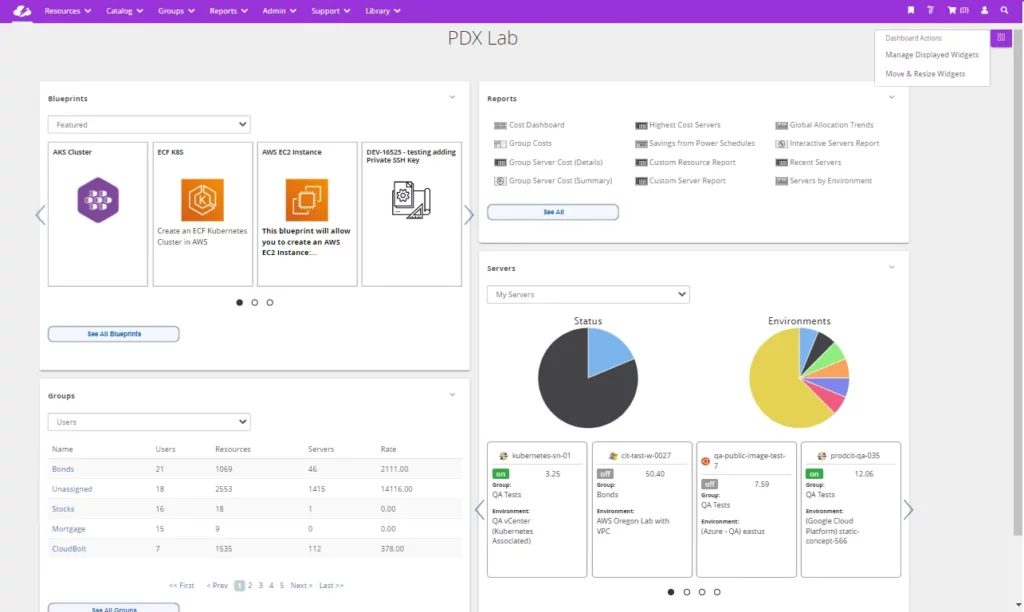
Best for: Enterprises managing multiple clouds with strict compliance needs.
CloudBolt provides hybrid cloud provisioning, policy automation, and FinOps management through its CloudBolt Platform and OneFuse integration. It supports 20+ environments, including AWS, Azure, GCP, VMware, and OpenStack.
The platform excels at governance and compliance, giving admins control over provisioning rules, role-based access, and cost allocation policies. Its integration with ServiceNow and Terraform makes it suitable for large organizations with established ITSM processes.
Key features:
- Multi-cloud provisioning and automation
- FinOps module for cost tracking
- Policy-based governance and compliance
- Integration with major ITSM and IaC tools
Why it stands out: CloudBolt provides enterprise-grade governance while maintaining flexibility across public and private environments — perfect for organizations with heavy compliance obligations.
8. IBM Turbonomic – Best Cloud Management Platform for Resource Optimization
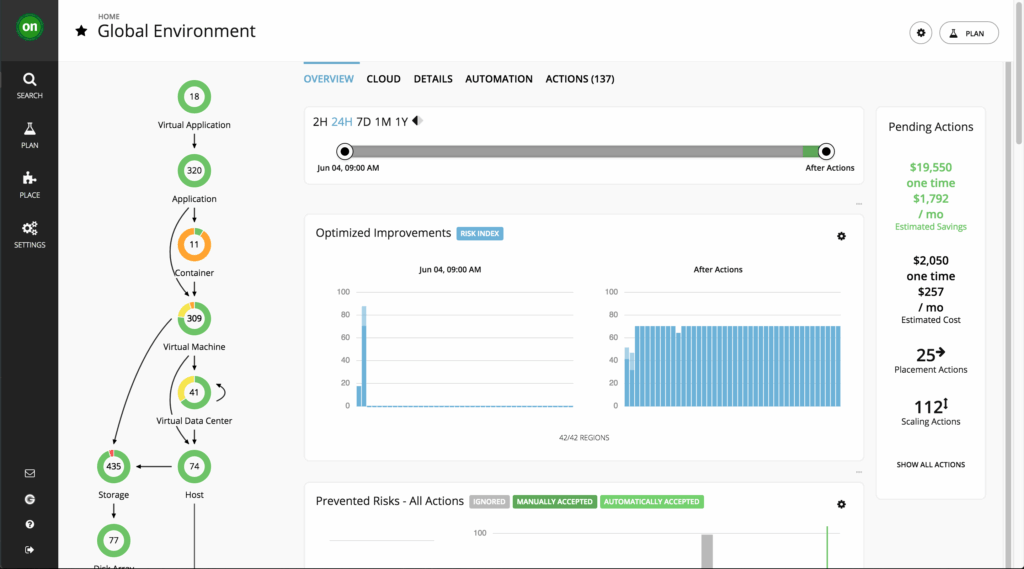
Best for: Enterprises seeking continuous cost-performance optimization.
IBM Turbonomic uses AI to analyze workloads and automatically adjust resources in real time. It continuously ensures applications get the resources they need without overprovisioning — preventing waste and reducing costs.
Turbonomic integrates with AWS, Azure, GCP, and VMware, giving a unified performance and cost optimization layer. It’s especially valuable for performance-critical environments like banking or healthcare.
Key features:
- Real-time AI-driven optimization
- Automated scaling and resource balancing
- Hybrid and multi-cloud visibility
- Application-centric cost analytics
Why it stands out: Turbonomic goes beyond reporting — it acts on insights automatically. Its AI engine makes it a strong choice for organizations ready for autonomous optimization.
9. Nutanix Cloud Platform – Best for Simplified Hybrid Cloud Operations
Best for: Companies running private clouds with a path to public expansion.
Nutanix Cloud Platform integrates compute, storage, and networking into a single hyper-converged infrastructure (HCI). With Prism Central, teams gain unified visibility, monitoring, and automation across hybrid environments.
It simplifies IT operations with one-click scaling, cost visibility, and cross-cloud mobility. Nutanix also provides cloud cost governance through its FinOps integration module, helping organizations manage expenses while maintaining performance.
Key features:
- Unified management of private and public workloads
- HCI architecture with simplified scaling
- Cost visibility and optimization features
- Strong focus on reliability and performance
Why it stands out: Nutanix offers a pragmatic path to hybrid cloud — starting from private infrastructure and extending into the public cloud without complexity.
10. Apptio Cloudability – Best for FinOps Analytics and Forecasting
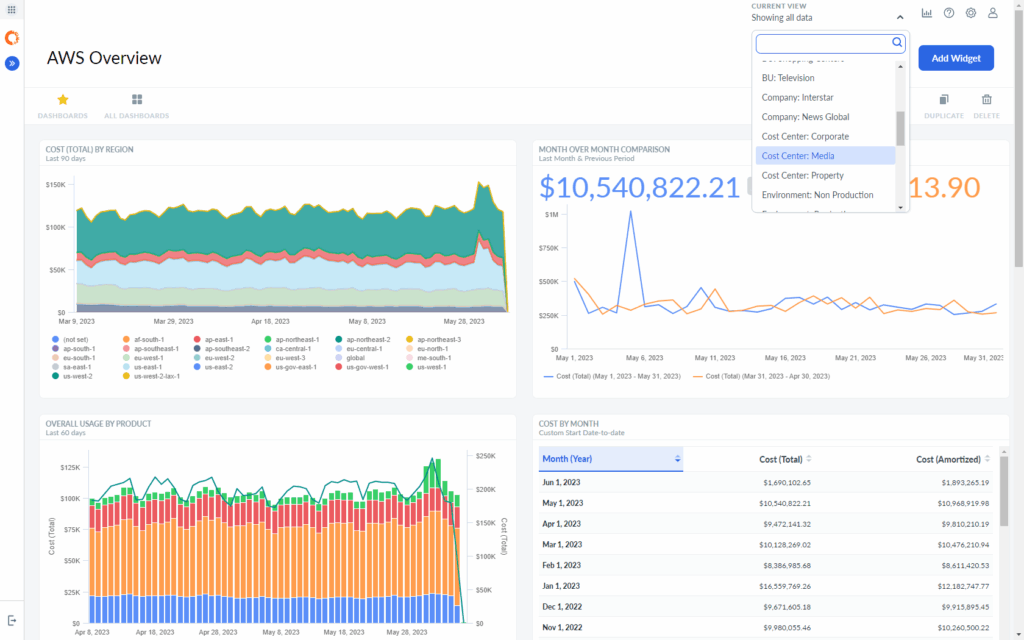
Best for: Finance and FinOps teams focused on analytics and optimization.
Apptio Cloudability remains a cornerstone of FinOps maturity. It specializes in cost allocation, forecasting, and optimization across AWS, Azure, and GCP. Enterprises use it to track usage trends, optimize Reserved Instance and Savings Plan commitments, and forecast future spend.
Apptio’s strength lies in its analytics engine, which helps finance teams correlate spending with business outcomes. It also provides benchmark data to evaluate efficiency against industry peers.
Key features:
- Detailed cost allocation and forecasting
- Savings Plan and RI optimization
- Integration with enterprise financial systems
- Benchmarking and performance reporting
Why it stands out: Apptio pioneered FinOps analytics and remains the standard for financial governance and cost reporting across multi-cloud environments.
Conclusion
In 2026, cloud management is no longer just about control — it’s about clarity and collaboration. The best platforms combine FinOps transparency with hybrid operational visibility, empowering teams to make data-driven infrastructure decisions.
Holori leads this new generation with its visual, intuitive approach to FinOps and infrastructure management — and unlike many other platforms, it’s designed to scale for both large enterprises and smaller companies.
- CloudHealth, Flexera, and Apptio provide deep enterprise-grade analytics and cost governance.
- Red Hat, OpenStack, and Nutanix enable hybrid flexibility with strong open-source or private cloud control.
- Morpheus, CloudBolt, and Turbonomic add orchestration, automation, optimization to the mix.
As multi-cloud complexity grows, these tools are redefining how organizations balance agility, performance, and cost — and platforms like Holori are leading the way toward truly unified cloud management.
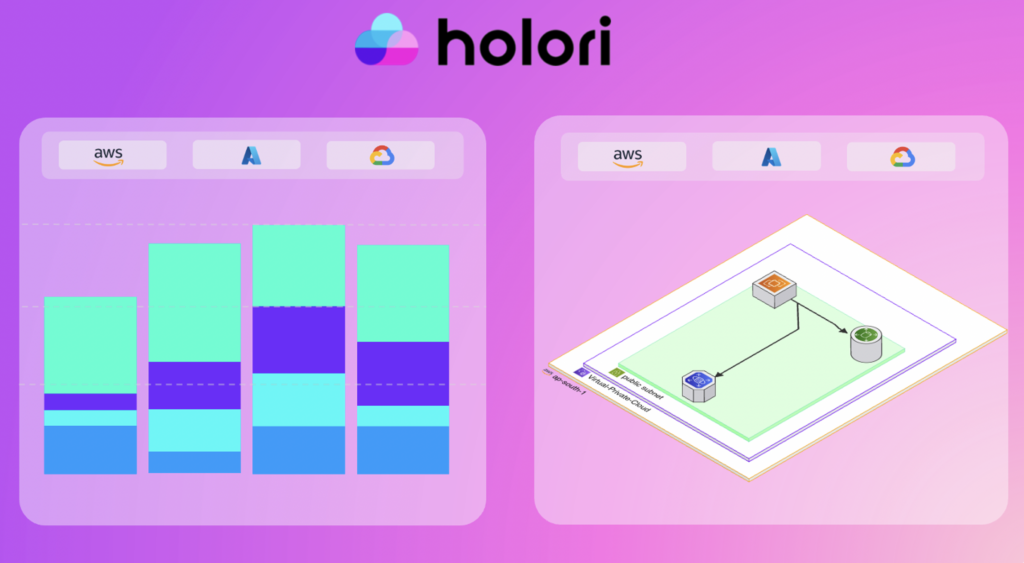
What is a Cloud Management Platform (CMP)?
A Cloud Management Platform is a tool that provides unified visibility, governance, automation, and cost optimization across public, private, and hybrid cloud environments. CMPs simplify cloud operations, improve collaboration, and enable FinOps practices.
Why do organizations need a CMP?
As companies adopt multi-cloud and hybrid strategies, managing costs, compliance, and performance becomes complex. CMPs centralize monitoring, enforce policies, automate workflows, and provide actionable insights to optimize cloud spending.
What are the key benefits of using a CMP?
- Unified visibility across clouds and on-prem environments
- Cost optimization and FinOps support
- Automation of provisioning and policy enforcement
- Improved governance and compliance
- Enhanced collaboration between finance, operations, and engineering teams
How do CMPs help with FinOps?
CMPs provide cost dashboards, forecasting, rightsizing recommendations, and budget alerts. They enable finance and engineering teams to collaborate, track spending, and optimize resource usage in real time.
What should I look for in a CMP in 2026?
- Multi-cloud and hybrid support
- Advanced FinOps capabilities
- Automation and policy management
- User-friendly dashboards and visualizations
- Scalability, security, and integration with DevOps tools
- Transparent pricing and measurable ROI
Which CMP is best for cost visibility and infrastructure mapping?
Holori is ideal for teams needing unified cost dashboards, automated cloud diagrams, Virtual Tags for consistent allocation, and multi-cloud cost recommendations — all in one intuitive platform.
Can CMPs work with open-source or private clouds?
Absolutely. OpenStack, Red Hat Cloud Suite, and Nutanix provide control over private and hybrid clouds, while integrating with cost-tracking or FinOps platforms for financial visibility.

